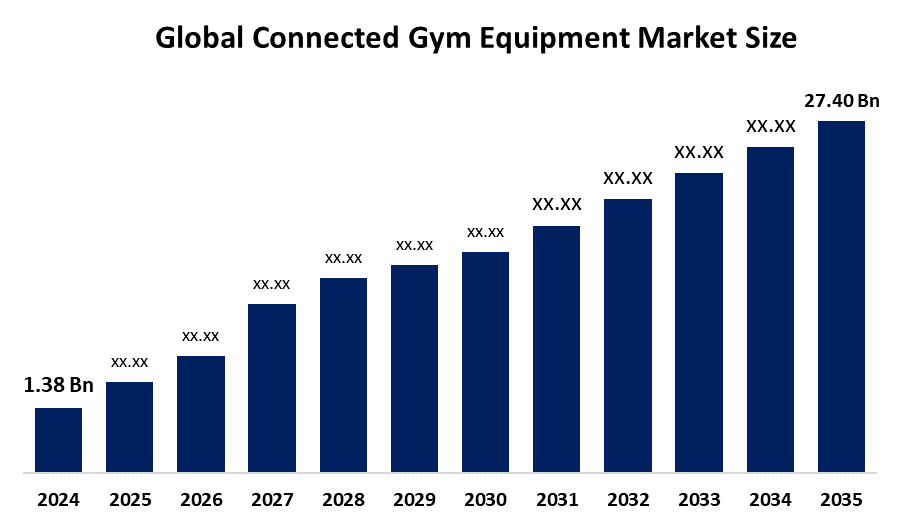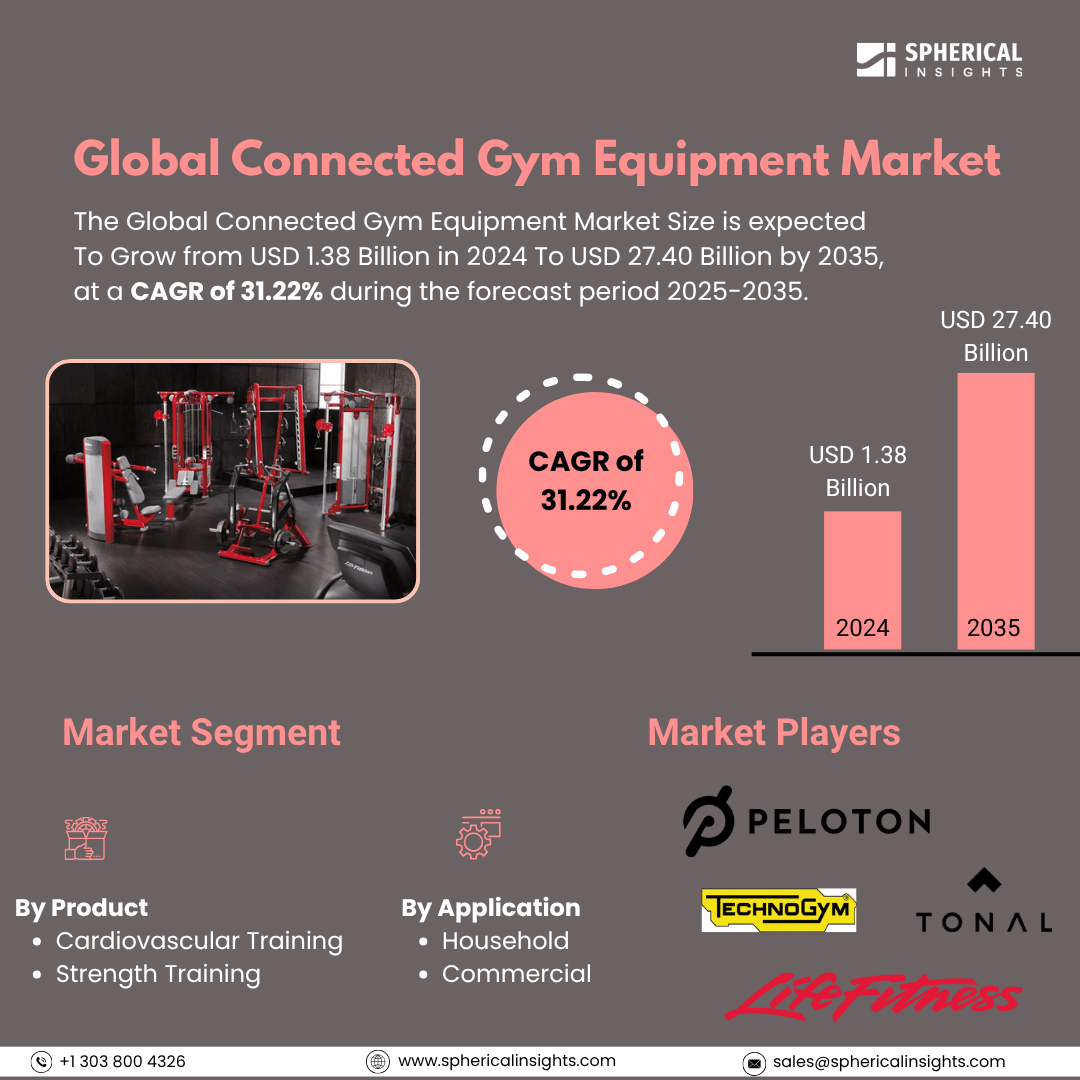Global Connected Gym Equipment Market Insights Forecasts to 2035
- The Global Connected Gym Equipment Market Size Was Estimated at USD 1.38 Billion in 2024
- The Market Size is Expected to Grow at a CAGR of around 31.22% from 2025 to 2035
- The Worldwide Connected Gym Equipment Market Size is Expected to Reach USD 27.40 Billion by 2035
- Asia Pacific is expected to grow the fastest during the forecast period.

Connected Gym Equipment Market
The connected Gym Equipment market encompasses fitness machines integrated with digital technologies such as Bluetooth, Wi-Fi, sensors, and cloud connectivity. These smart devices allow users to track their workouts, monitor vital health metrics, and connect to fitness apps or virtual training platforms. Common examples include internet-enabled treadmills, stationary bikes, ellipticals, and strength-training machines. These systems often provide features like real-time performance feedback, workout history, and remote access to professional training programs. Designed for both home and commercial use, connected gym equipment enhances the fitness experience by combining physical exercise with interactive and data-driven tools. The market includes offerings from established fitness brands as well as tech-driven startups, reflecting a broad range of products tailored to different user needs. With expanding digital integration in the fitness space, connected gym equipment continues to evolve, offering more personalized and immersive workout options across global markets in both residential and commercial fitness settings.
Attractive Opportunities in the Connected Gym Equipment Market
- With improving digital infrastructure and rising health and fitness awareness in regions like Asia Pacific, Latin America, and the Middle East & Africa, there is significant potential to tap into new customer bases. Increasing internet access and smartphone penetration make these markets ripe for connected fitness solutions.
- Creating smart gym equipment tailored for seniors and individuals with disabilities can open up a broader user base. Designing accessible, easy-to-use connected fitness devices can meet the needs of underserved populations and promote wellness inclusivity.
Global Connected Gym Equipment Market Dynamics
DRIVER: Rising health awareness and the increasing focus on fitness
Rising health awareness and the increasing focus on fitness and wellness have led consumers to seek more engaging and data-driven workout solutions. The integration of advanced technologies such as IoT, artificial intelligence, and cloud computing into fitness equipment has enabled real-time performance tracking, virtual coaching, and personalized workout experiences, enhancing user motivation and accountability. The surge in demand for home fitness solutions, especially post-pandemic, has accelerated the adoption of connected equipment as users look for convenient and interactive ways to stay fit at home. Additionally, the growing popularity of digital fitness platforms and hybrid workout models has encouraged equipment manufacturers to offer devices compatible with various fitness apps and online training programs. The increasing investment by tech companies and fitness brands in innovation and partnerships further supports the expansion of this market by delivering more immersive and connected fitness ecosystems.
RESTRAINT: Connected gym equipment market is the high cost of these smart machines
One of the main restraining factors for the connected gym equipment market is the high cost of these smart machines, which makes them less accessible to many consumers and smaller fitness centers. Unlike traditional equipment, connected machines often require expensive components like sensors, screens, and software, increasing the overall price. Additionally, ongoing maintenance, software updates, and repairs can be costly and may require specialized support. Another challenge is data privacy and security concerns, as users are often wary of sharing personal health information online. Connectivity issues, such as problems syncing with apps or other devices, can also lead to frustration and limit the user experience. In some regions, especially in developing markets, there is still low awareness of connected fitness technology, and people who are less comfortable with digital tools may be hesitant to adopt it. These factors together can slow down the growth of the connected gym equipment market.
OPPORTUNITY: Expanding into emerging markets where digital infrastructure is improving and interest in health and fitness is rising
One key opportunity lies in expanding into emerging markets where digital infrastructure is improving and interest in health and fitness is rising. As internet access and smartphone use grow, these regions represent untapped potential for connected fitness solutions. Another opportunity is the development of inclusive and adaptive equipment tailored for seniors or individuals with disabilities, opening up a broader user base. Integration with healthcare systems and wellness programs could also create value, allowing for equipment that supports physical therapy, remote health monitoring, or preventive care. Moreover, advancements in augmented and virtual reality (AR/VR) can offer immersive workout experiences, making exercise more engaging and interactive. There is also potential in offering subscription-based or pay-as-you-go models to reduce upfront costs and attract a wider audience. These opportunities can help companies reach new demographics and diversify revenue streams in a competitive market.
CHALLENGES: Fast pace of technology changes new features and updates are released often
Apart from the common restraints, the connected gym equipment market faces other challenges that affect its growth. One big challenge is the fast pace of technology changes new features and updates are released often, which can make existing machines feel outdated quickly. This puts pressure on companies to keep upgrading their products. Another issue is keeping users engaged over time, as many people stop using the equipment even if it offers interactive features. Compatibility between different devices and fitness platforms can also be a problem, as users want a smooth and connected experience. In addition, many users now expect personalized workouts, and if the equipment fails to meet those expectations, it can reduce satisfaction. The market is also becoming crowded with both well-known fitness brands and new tech startups, making it harder for companies to stand out. All of these challenges must be managed carefully to succeed in this growing industry.
Global Connected Gym Equipment Market Ecosystem Analysis
The global connected gym equipment market ecosystem includes equipment manufacturers, technology providers, digital fitness platforms, distributors, and end users. Manufacturers produce smart machines with IoT features, while tech firms supply software, sensors, and cloud services. Platforms like Apple Fitness+ and Zwift offer interactive content. Retailers distribute to homes and gyms, while healthcare providers increasingly integrate fitness tracking into wellness programs. Regulatory bodies and cybersecurity firms ensure compliance and data protection, creating a secure, interconnected system focused on personalized, tech-driven fitness experiences.
Based on the product, the cardiovascular training held the dominant market share during the forecast period

Cardiovascular training equipment held the dominant share of the global connected gym equipment market during the forecast period. This category includes smart treadmills, stationary bikes, ellipticals, and rowers equipped with digital connectivity and interactive features. The popularity of cardiovascular machines is driven by their widespread use for effective calorie burning, heart health improvement, and adaptability for all fitness levels. Their integration with apps and virtual training platforms enhances user engagement, making them a preferred choice among consumers and fitness facilities worldwide.
Based on the application, the commercial application held a considerable market share and is expected to grow at a significant CAGR during the forecast period

The commercial segment held a considerable share of the global connected gym equipment market and is expected to grow at a significant CAGR during the forecast period. This growth is driven by gyms, fitness centers, hotels, and corporate wellness programs investing in advanced connected equipment to offer enhanced workout experiences and attract members. The demand for interactive, data-driven fitness solutions in commercial settings continues to rise, fueling market expansion and encouraging further innovation in connected gym technologies.
North America is anticipated to hold the largest market share of the connected gym equipment market during the forecast period
North America is anticipated to hold the largest market share of the connected gym equipment market during the forecast period. This leadership is attributed to the region’s high health awareness, early adoption of advanced fitness technologies, and the presence of major industry players. Additionally, widespread internet penetration, a strong fitness culture, and growing demand for at-home and commercial connected gym solutions contribute to market growth. The region’s well-established digital infrastructure and increasing investments in smart fitness innovations further reinforce its dominant position.
Asia Pacific is expected to grow at the fastest CAGR in the connected gym equipment market during the forecast period
Asia Pacific is expected to grow at the fastest CAGR in the connected gym equipment market during the forecast period. This rapid growth is driven by increasing urbanization, rising disposable incomes, and growing health consciousness among consumers. Additionally, expanding internet connectivity and smartphone penetration are enabling greater access to digital fitness solutions. The region’s large population, coupled with rising investments from fitness equipment manufacturers and technology providers, is fueling demand for connected gym equipment in both home and commercial settings.
Recent Development
- In March 2024, Life Fitness announced that the company was set to introduce the latest generation of cardiovascular training and strength training equipment with digital product innovations at the IHRSA Convention & Trade Show 2024. The company is expected to launch Symbio - its ultra-premium cardio line.
Key Market Players
KEY PLAYERS IN THE CONNECTED GYM EQUIPMENT MARKET INCLUDE
- Peloton Interactive, Inc.
- Technogym S.p.A.
- Life Fitness (Brunswick Corporation)
- NordicTrack (ICON Health & Fitness)
- Tonal
- Echelon Fitness
- Precor (Peloton-owned)
- EGYM GmbH
- Matrix Fitness
- Cybex International
- Others
Market Segment
This study forecasts revenue at global, regional, and country levels from 2020 to 2035. Spherical Insights has segmented the connected gym equipment market based on the below-mentioned segments:
Global Connected Gym Equipment Market, By Product
- Cardiovascular Training
- Strength Training
Global Connected Gym Equipment Market, By Application
Global Connected Gym Equipment Market, By Regional Analysis
- North America
- Europe
- Germany
- UK
- France
- Italy
- Spain
- Russia
- Rest of Europe
- Asia Pacific
- China
- Japan
- India
- South Korea
- Australia
- Rest of Asia Pacific
- South America
- Brazil
- Argentina
- Rest of South America
- Middle East & Africa
- UAE
- Saudi Arabia
- Qatar
- South Africa
- Rest of the Middle East & Africa






